 |

| |
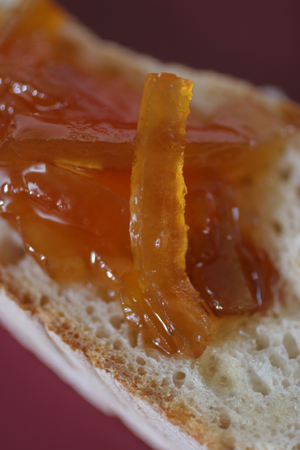
Robert Lambert creates a Five Grapefruit Marmalade with great flavor by combining white cocktail grapefruits with Mandalo grapefruit and three grapefruit hybrids—the Poorman orange, the Japanese Shekwasha and the citrumelo. Photo by Naheed Choudhry. |
| WHAT IT IS: Artisan marmalades in grapefruit, lemon, lime and orange. |
| WHY IT’S DIFFERENT: Complex flavors are achieved by using different fruits from the same genus: three different varieties of lemon, five different varieties of grapefruit and lime. There are marmalades from four different oranges: not just the tried-and-true Seville, but the bergamot, the blood orange and the calamondin. |
| WHY WE LOVE IT: Lambert’s craftsmanship lets the flavors of the fruit soar; a modicum of sugar means that you taste the fruit as you would from the source, not from the sugar bowl. And the marmalades are so thick, they’re almost jars of solid fruit. |
| WHERE TO BUY IT: RobertLambert.com |
|
|
 |

Robert Lambert Marmalade:
Super Citrus
Great Britain, take note: Californian Robert Lambert has raised the bar on marmalade, and instead of exporting your products to the U.S., you will want to import his. Finally, it makes sense to bring coals to Newcastle!
Don’t ask why one needs four different types of orange marmalade—Seville, bergamot orange, blood orange and calamondin. The question is, what to remove from the refrigerator shelf to make room for them. Beyond orange marmalade, there’s an Exotic Lemon Trio Marmalade, a Five Grapefruit Marmalade and a Five Lime Marmalade. Make room for those, too. Our biggest challenge was not the investment in the entire line, but tossing out other beloved condiments to make room for the seven new jars. While we had a twinge of regret at the moment of decision, we haven’t looked back since.
Lambert purchases only the finest fruits—most hand-picked on family farms. His deft hand at cooking them means that you taste the fruit, not the sugar. Each type of citrus contributes its uniqueness, like the different brass, strings and woodwinds in an orchestra. Once having tasted such melody, few people who enjoy great food will desire other marmalades. We use these snazzy fruits as all-around condiments—with toast, but also with eggs, pancakes, cheese, as meat glazes, in yogurt and in marinades. When one jar empties, it is quickly replaced. Nature abhors both a vacuum and an empty shelf. Read the full review below.
- Read reviews of more of our favorite gourmet jams and jellies in THE NIBBLE online magazine.
- See the Table of Contents of the August issue of THE NIBBLE, plus the back issues archive and our most popular articles.
- All of the Top Pick Of The Week newsletters are permanently archived on TheNibble.com, in chronological order and by product category.
|
| |
|
|
THE NIBBLE does not sell the foods we review
or receive fees from manufacturers for recommending them.
Our recommendations are based purely on our opinion, after tasting thousands of products each year, that they represent the best in their respective categories. |
Jam Pots For Your Marmalades
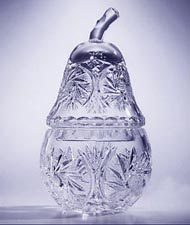 |
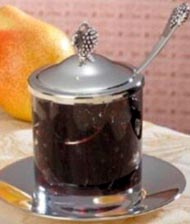 |
|
| Crystal Jam Jar. This pear-shaped jam jar is seven-inches tall. The graceful 24% lead crystal accessory will add a graceful touch to your table. Gift boxed. Click here for more information or to purchase. |
Silver-Plated Set With Grape Finial. This glass jelly/sugar jar has a silver-plated tray, lid and serving spoon—easy to clean and to enjoy the beauty of the jam. Click here for more information or to purchase. |
|
Robert Lambert Marmalade: Super Citrus
INDEX OF REVIEW
|
MORE TO DISCOVER
|
Robert Lambert is a chef, food writer, caterer and producer of artisan foods who focuses on creating product lines that don’t exist in the marketplace. He does such a stellar job with his specialty foods that we are glad the man is not behind the stove of a restaurant—as good as that restaurant would be. He doesn’t make “another line of gourmet jam,” for example; he focuses on marmalade. And he has elevated what one thinks of as orange, grapefruit, lemon and lime marmalade to such a level, that any society of marmalade lovers should seek him out for an award.
What Is Marmalade?
Marmalade is a soft jelly, often citrus-based, that includes both the flesh and peel of the fruit, suspended throughout the jelly base. The sweetness of the jelly is offset by the bitterness of the peel.
While jams have been made for thousands of years, the word marmalade derives from the Portuguese word for quince, marmelo. A quince marmelada was first made in the Middle Ages, mixed with honey and spices. It was not the kind of marmalade we know today, but similar to the firm quince paste known as membrillo (look for it at cheese counters—it’s delicious with semihard and hard cheeses).
In the late 18th century, the British discovered that if the pulp of oranges was boiled with sugar and chopped peel, no fruit pectin was needed to set the jam. Seville oranges—bitter oranges from Seville, Spain—became their preferred fruit. Today, most marmalades are made with oranges, but other citrus fruits—grapefruit, tangerines, limes and lemons—are often found, alone or in mixed fruit combinations. There are products called “marmalade” made from other fruits suspended in a clear jelly base (mango and pineapple marmalades, e.g.). And there are products called marmalade that are not marmalades at all, but jams or preserves misnamed “marmalade.” Onion and tomato marmalades, for example, are actually savory preserves or jams.
|
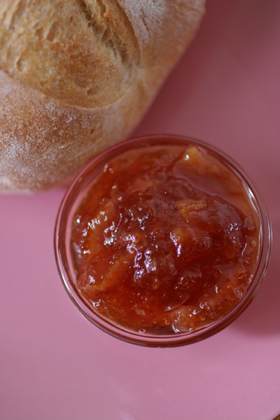
Blood Orange Marmalade. The flesh of the blood
orange is raspberry-colored, producing a rosy marmalade that has berry flavors, too.
|
Robert Lambert’s marmalades are hand-crafted in small batches, as the finest artisan foods must be, to supervise quality. To make marmalade, the fruit is julienned and every seed is removed by hand. (Larger-batch products would never use exotic fruit: The hand labor, cutting and picking out the many seeds from rare fruits, is time-consuming and exhausting—an artisan labor of love.) Since the pectin that causes the jelly to set resides in the fruit’s seeds as well as in the pith of the peel, the seeds are tied in a bag and added back to the fruit to cook. Water is added to the fruit, which soaks for a while; then the mixture is boiled down to release the pectin. Cane sugar is added, then the mixture is boiled down again until it reaches the setting point. It is cooled and jarred.
Citrus marmalade has a peak shelf life of two or three years, and improves with age—sometimes beyond anyone’s expectations. A tin of Frank Cooper’s marmalade, taken on Robert Scott’s expedition to the North Pole in 1911, was opened in 1980 and found to be in excellent condition.
Back to Index
JAM AND JELLY GLOSSARY
Is your naked bread unsure of what it wants for its topping? Help it understand the differences among jams, jellies, preserves, etc. |
Robert Lambert Marmalade Flavors
When you look at the exotic grapefruits, lemons, limes and oranges used in Robert Lambert’s marmalades, it’s a surprise to realize that all of this wonderful citrus grows in his greater backyard, California. (The message: Please buy exotic produce whenever you see it—support the family farms that are keeping these wonderful varieties alive.) He sources it himself, meeting the growers at farmers’ markets and otherwise learning of interesting fruits growing in the region—often going to pick the fruit himself, ensuring that every piece is choice. In addition to the painstaking labor is Mr. Lambert’s superb palate and relentless pursuit of perfection.
When you open the jar of marmalade, the first thing you’ll notice is how chunky and exciting it looks—like real fruit, minimally processed. That’s because the peel is all hand-cut (larger-batch marmalades use machines).
To achieve his outstanding flavor profiles, Lambert blends different fruits: three varieties of lemon, five grapefruits and limes. Even the single-variety orange marmalades have a bit of a complementary orange as a counterpoint to the bitter, sweet or sour profile of the main orange. A portion of the water in a typical marmalade recipe is replaced by fruit juice—Meyer lemon, orange, Palestinian sweet lime and/or Rangpur lime. This intensifies the flavor and adds complexity. It adds to the cost, too—but one taste and you’ll know that you get what you pay for.
Each marmalade is superb. Explore beyond what you think you like. Our absolute favorites ended up not being those we would have picked as our top three, based on our regular “favorite foods.”
- Bergamot Orange Marmalade may taste somewhat familiar to some: The bergamot orange is used to flavor Earl Grey tea. You can clearly see where the flavor comes from, and it’s a perfect gift for an Earl Grey lover. Serve it with cheese and crackers, too.
- Blood Orange Marmalade is a sweet marmalade bursting with blood orange flavor. We have a penchant for that raspberry-orange flavor, and love a good blood orange. It’s a treat to find it in a marmalade.
- Calamondin Marmalade mixes the calamondin orange with some Rangpur lime and a bit of orange and Meyer lemon juices. The flavor is orange with a tinge of melon-like quality. Calamondin is a southeast Asian orange that resembles a small, round lime and has the aroma of a tangerine. Also called an acid orange, calamansi orange or Panama orange, the juice is sour and is often used in savory dishes.
- Seville Orange Marmalade is a delight, with tiny nuances of honeydew and even coconut (Lambert blends a small amount of bergamot orange for perfume, and Meyer lemon, which has some orange parentage, for complexity). British marmalade is made from Seville oranges, a sour orange (though the marmalade isn’t sour).
|
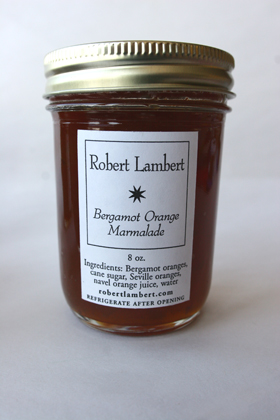
We drink Earl Grey tea every day. What a delight
to find bergamot orange, its familiar flavoring,
in a marmalade.
|
| |
If you have any British brands, taste them against this Seville marmalade. It is like comparing a normal steak to Kobe beef. So, caveat emptor: If you love orange marmalade and have a refined palate, be prepared to make a permanent switch. There’s no going back to the simplistic, sugary stuff. |
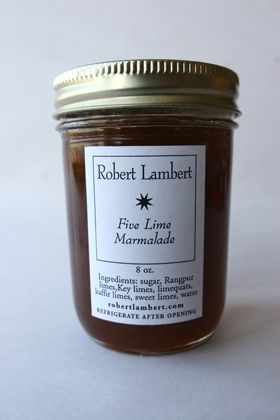
Five Lime Marmalade: Slightly tart, it complements savory foods, too. |
- Exotic Lemon Trio Marmalade
The trio tastes like a chamber orchestra of lemon. You can taste the yuzu and the Meyer lemon, two exotic species that have grown very popular with leading chefs and can be found with greater frequency in specialty produce markets. The Texas lemon is harder to come by, a hybrid with notes of citron and grapefruit.
- Five Grapefruit Marmalade blends white cocktail grapefruit with Mandalo grapefruit, the Poorman orange, a grapefruit hybrid, and two hybrids with tropical fruit notes, the Shekwasha, a Japanese citrus, and the Sacaton citrumelo, a hybrid of the hardy orange, and the pomelo. Each adds a distinctive flavor to achieve a lovely grapefruit experience, beautifully rounded with no bitterness or tartness.
- Five Lime Marmalade is perhaps the most tart marmalade, but it’s a very slight pucker. There’s an entire lime festival going on here: Kaffir limes, Key limes, Tavares limequats (a cross between the lime and the kumquat), Palestinian sweet limes (an unusual citrus in that it contains no acid) and Rangpur limes (the Rangpur is a sour mandarin). The tartness makes this an interesting condiment for savory foods: scallops, poultry and lamb (it’s a sophisticate’s mint jelly).
|
Serving Suggestions
- At Breakfast. Enjoy on breads, of course; but also with pancakes and waffles, in yogurt and to sweeten hot cereal (instead of sugar).
- With Poultry, Meat and Seafood. Conserves—fruits, nuts and sugar, cooked until very thick, are often served with meats (cranberry relish is a conserve). Robert Lambert marmalades are thick enough and low enough in sweetness to accent dishes where you’d like a bit of sweetness or are using a citrus sauce: salmon and other fish, scallops, roast poultry, pork and lamb. Make a marinade of soy sauce, mustard and marmalade; or a fruit sauce by adding the marmalade to pan juices and reducing with some wine.
- With Dessert. Serve a dab with pound cake, angel food cake and sorbet. We put Calamondin orange on gourmet graham crackers (look for Starr Ridge and Tiny Trapeze graham crackers) and topped it with shaved bittersweet chocolate.
|
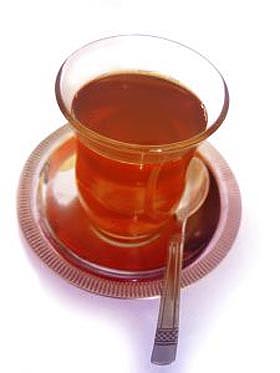
Try marmalade in your tea instead of sugar. Photo by Pakize Oztürk | Sxc.
|
- In Tea. Russians have traditionally sweetened tea with a spoonful of cherry preserves. If you like lemon in your tea, try some Exotic Lemon Trio Marmalade. Try Bergamot Marmalade in Earl Grey. Whatever you have, try it—it will work.
Marmalades are typically fruit and peel in a jelly base. These marmalades are so packed with fruit, it’s hard to find the jelly. That’s a guarantee of a jelly good time.
—Karen Hochman
FORWARD THIS NIBBLE to anyone who loves marmalade, preserves or jam.
Robert lambert marmalades
Bergamot Orange, Blood Orange, Calamondin, Exotic Lemon Trio, Five Grapefruit, Five Lime, Seville Orange
- 8-Ounce Jar
Any Flavor
$15.00
Purchase online at RobertLambert.com
Also available at fine specialty food stores. Prices and product availability are verified at publication but are subject to change. Shipping is additional.
|
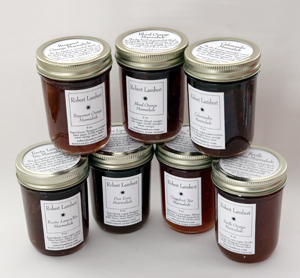
Robert Lambert’s marmalades: a symphony of citrus.
|
Read more about our favorite
spreads and other related products in
THE NIBBLE online magazine.
|
Check Out These Other “Top Picks Of The Week” From The Jam Group:
|
FOR ADDITIONAL INFORMATION, special offers,
contests, opinion surveys, THE NIBBLETM
back issues archive, product gift-finder, links to our favorite
food websites, and the ability to nominate your favorite nibbles,
visit www.TheNibble.com.
Do you have friends who would enjoy THE NIBBLE?
Click here to send them an invitation to sign up for their own copy. |
© Copyright 2004-2025 Lifestyle Direct, Inc. All rights
reserved. All information contained herein is subject to change at any time
without notice. All details must be directly confirmed with manufacturers, service
establishments and other third parties. The material in this e-zine may not
be reproduced, distributed, transmitted, cached, or otherwise used, except with
the prior written permission of Lifestyle Direct, Inc.
|
 |
|
 |












